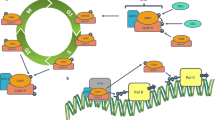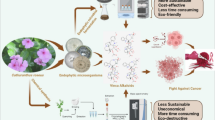Summary
Etoposide (VP-16), a topoisomerase II (Topo II) inhibitor, has been widely used to treat malignancies. Its clinical application, however, has been hindered by the rise of acquired multidrug resistance (MDR). Here, we report that 4β-{[4-(pyrrolidin-1-ylmethyl)phenyl]amino}-4′-O-Demethyl-4-Epipodophyllotoxin (5k), a novel β-O-demethyl-epipodophyllotoxin analogue, possesses higher antitumor activity than its parent compound (VP-16) in a panel of various human tumor cell lines. More importantly, it was also effective against MDR cells both in vitro and in vivo. Using a KB/VCR MDR tumor xenograft model that overexpresses P-gp, 5k (2.5 mg/kg) exhibited a 2.4-fold higher growth inhibition rate versus VP-16 (5 mg/kg). In contrast, 5k and VP-16 displayed similar antitumor activities in a KB tumor xenograft model. Molecular and cellular mechanism studies revealed that 5k targeted Topo II by trapping DNA-Topo II cleavage complexes that could directly cause DNA damage. There were two distinct cellular responses to DNA damage elicited by the treatment with 5k: at low concentrations (20–80 nM), mitotic entry was arrested through the suppression of the activity of Cyclin B1/Cdc 2 complexes via the ATM/ATR signaling pathway; at high concentrations (1.25–5.00 μM), 5k-induced apoptotic signaling was mediated by the mitochondrial death pathways. Collectively, these data demonstrate the potential value of 5k as an antitumor drug candidate that should be further developed.







Similar content being viewed by others
Abbreviations
- 5k :
-
4β-{[4-(pyrrolidin-1-ylmethyl)phenyl]amino}-4′-O-Demethyl-4-Epipodophyllotoxin
- DAPI:
-
4′6-diamidino-2-phenylindole
- JC-1:
-
5,5′6,6′-tetrachloro-1,1′3,3′-tetraethylbenzimidazol-carbocyanine iodide
- ΔΨ:
-
mitochondrial membrane potential
- MDR:
-
multidrug resistance
- DDR:
-
DNA damage response
- Topo II:
-
Topoisomerase II
- VCR:
-
vincristine
- RTV:
-
relative tumor volume
- ATM:
-
Ataxia-Telangiectasia Mutated
- ATR:
-
Ataxia-Telangiectasia and Rad3 related
- p-:
-
phosphorylated
References
Bakshi R, Galande S, Muniyappa K (2001) Substrate specificity plays an important role in uncoupling the catalytic and scaffolding activities of rat testis DNA topoisomerase IIalpha. J Biomol Struct Dyn 18(5):749–760
Montecucco A, Biamonti G (2007) Cellular response to etoposide treatment. Cancer Lett 252(1):9–18
Hande KR (1998) Etoposide: four decades of development of a topoisomerase II inhibitor. Eur J Cancer 34(10):1514–1521
Meresse P, Dechaux E, Monneret C, Bertounesque E (2004) Etoposide: discovery and medicinal chemistry. Curr Med Chem 11(18):2443–2466
Hoeijmakers JH (2001) Genome maintenance mechanisms for preventing cancer. Nature 411(6835):366–374
Kastan MB, Bartek J (2004) Cell-cycle checkpoints and cancer. Nature 432(7015):316–323
Bartek J, Lukas J (2007) DNA damage checkpoints: from initiation to recovery or adaptation. Curr Opin Cell Biol 19(2):238–245
Bartek J, Bartkova J, Lukas J (2007) DNA damage signalling guards against activated oncogenes and tumour progression. Oncogene 26(56):7773–7779
Shiloh Y (2001) ATM and ATR: networking cellular responses to DNA damage. Curr Opin Genet Dev 11(1):71–77
Pauklin S, Kristjuhan A, Maimets T, Jaks V (2005) ARF and ATM/ATR cooperate in p53-mediated apoptosis upon oncogenic stress. Biochem Biophys Res Commun 334(2):386–394
Hutt AM, Kalf GF (1996) Inhibition of human DNA topoisomerase II by hydroquinone and p-benzoquinone, reactive metabolites of benzene. Environ Health Perspect 104(6):1265–1269
Lindqvist A, van Zon W, Karlsson Rosenthal C, Wolthuis RM (2007) Cyclin B1-Cdk1 activation continues after centrosome separation to control mitotic progression. PLoS Biol 5(5):e123
Rogakou EP, Pilch DR, Orr AH, Ivanova VS, Bonner WM (1998) DNA double-stranded breaks induce histone H2AX phosphorylation on serine 139. J Biol Chem 273(10):5858–5868
Pines J (1999) Cell cycle. Checkpoint on the nuclear frontier. Nature 397(6715):172–175
Sancar A, Lindsey-Boltz LA, Unsal-Kacmaz K, Linn S (2004) Molecular mechanisms of mammalian DNA repair and the DNA damage checkpoints. Annu Rev Biochem 73:39–85
Wang XM, Li J, Feng XC, Wang Q, Guan DY, Shen ZH (2008) Involvement of the role of Chk1 in lithium-induced G2/M phase cell cycle arrest in hepatocellular carcinoma cells. J Cell Biochem 104(4):1181–1191
Chen T, Wong YS (2008) Selenocystine induces apoptosis of A375 human melanoma cells by activating ROS-mediated mitochondrial pathway and p53 phosphorylation. Cell Mol Life Sci 65(17):2763–2775
Ye J, Wang S, Leonard SS, Sun Y, Butterworth L, Antonini J, Ding M, Rojanasakul Y, Vallyathan V, Castranova V, Shi X (1999) Role of reactive oxygen species and p53 in chromium (VI)-induced apoptosis. J Biol Chem 274(49):34974–34980
Xue L, Zhou B, Liu X, Qiu W, Jin Z, Yen Y (2003) Wild-type p53 regulates human ribonucleotide reductase by protein-protein interaction with p53R2 as well as hRRM2 subunits. Cancer Res 63(5):980–986
Yang Z, Wu D, Bui T, Ho RJ (2008) A novel human multidrug resistance gene MDR1 variant G571A (G191R) modulates cancer drug resistance and efflux transport. J Pharmacol Exp Ther 327(2):474–481
Siegel RM (2006) Caspases at the crossroads of immune-cell life and death. Nat Rev Immunol 6(4):308–317
Taylor BF, McNeely SC, Miller HL, Lehmann GM, McCabe MJ Jr, States JC (2006) p53 suppression of arsenite-induced mitotic catastrophe is mediated by p21CIP1/WAF1. J Pharmacol Exp Ther 318(1):142–151
Smits VA, Klompmaker R, Vallenius T, Rijksen G, Mäkela TP, Medema RH (2000) p21 inhibits Thr161 phosphorylation of Cdc2 to enforce the G2 DNA damage checkpoint. J Biol Chem 275(39):30638–30643
Yu J, Guo QL, You QD, Zhao L, Gu HY, Yang Y, Zhang HW, Tan Z, Wang X (2007) Gambogic acid-induced G2/M phase cell-cycle arrest via disturbing CDK7-mediated phosphorylation of CDC2/p34 in human gastric carcinoma BGC-823 cells. Carcinogenesis 28(3):632–638
Norbury CJ, Zhivotovsky B (2004) DNA damage-induced apoptosis. Oncogene 23(16):2797–2808
Ryan L, O’Callaghan YC, O’Brien NM (2005) The role of the mitochondria in apoptosis induced by 7beta-hydroxycholesterol and cholesterol-5beta, 6beta-epoxide. Br J Nutr 94(4):519–525
Gaul L, Mandl-Weber S, Baumann P, Emmerich B, Schmidmaier R (2008) Bendamustine induces G2 cell cycle arrest and apoptosis in myeloma cells: the role of ATM-Chk2-Cdc25A and ATM-p53-p21-pathways. J Cancer Res Clin Oncol 134(2):245–253
Clifford B, Beljin M, Stark GR, Taylor WR (2003) G2 arrest in response to topoisomerase II inhibitors: the role of p53. Cancer Res 63(14):4074–4081
Siu WY, Lau A, Arooz T, Chow JP, Ho HT, Poon RY (2004) Topoisomerase poisons differentially activate DNA damage checkpoints through ataxia-telangiectasia mutated-dependent and -independent mechanisms. Mol Cancer Ther 3(5):621–632
Author information
Authors and Affiliations
Corresponding authors
Additional information
This work was supported by the Scientific Research Foundation of Zhejiang Provincial Health Bureau (No. 2008A043), Natural Science Foundation of Zhejiang Province (Z2090053).
Electronic Supplementary Materials
Below is the link to the electronic supplementary material.
Figure S1
The chromatogram of 5k. To validate the purity, liquid chromatography–mass spectrum analysis was performed. UV absorbance at 254 nm, the y-axis (Au) means the absorbance, while the x-axis represents elution time (min). Area percent was calculated, the purity of 5k was 99.86%. (GIF 109 kb)
Figure S2
Effects of 5k and VP-16 on P-gp ATPase activity. The decrease in luminescence of untreated samples compared to samples plus Na3VO4 represents basal P-gp ATPase activity. The P-gp ATPase activity in response to the treatment of verapamil (200 μM), 5k (100 μM, 25 μM), VP-16(100 μM, 25 μM) were expressed as the percentage of basal activity. (GIF 79 kb)
Figure S3
Morphological alterations of KB cells after 5.0 μM 5k exposition in the presence or absence of 100 μM Boc-D-FMK pretreatment for 30 min, detected by microscope at the same magnification. (GIF 144 kb)
Rights and permissions
About this article
Cite this article
Xu, D., Cao, J., Qian, S. et al. 5k, a novel β-O-demethyl-epipodophyllotoxin analogue, inhibits the proliferation of cancer cells in vitro and in vivo via the induction of G2 arrest and apoptosis. Invest New Drugs 29, 786–799 (2011). https://doi.org/10.1007/s10637-010-9423-5
Received:
Accepted:
Published:
Issue Date:
DOI: https://doi.org/10.1007/s10637-010-9423-5




